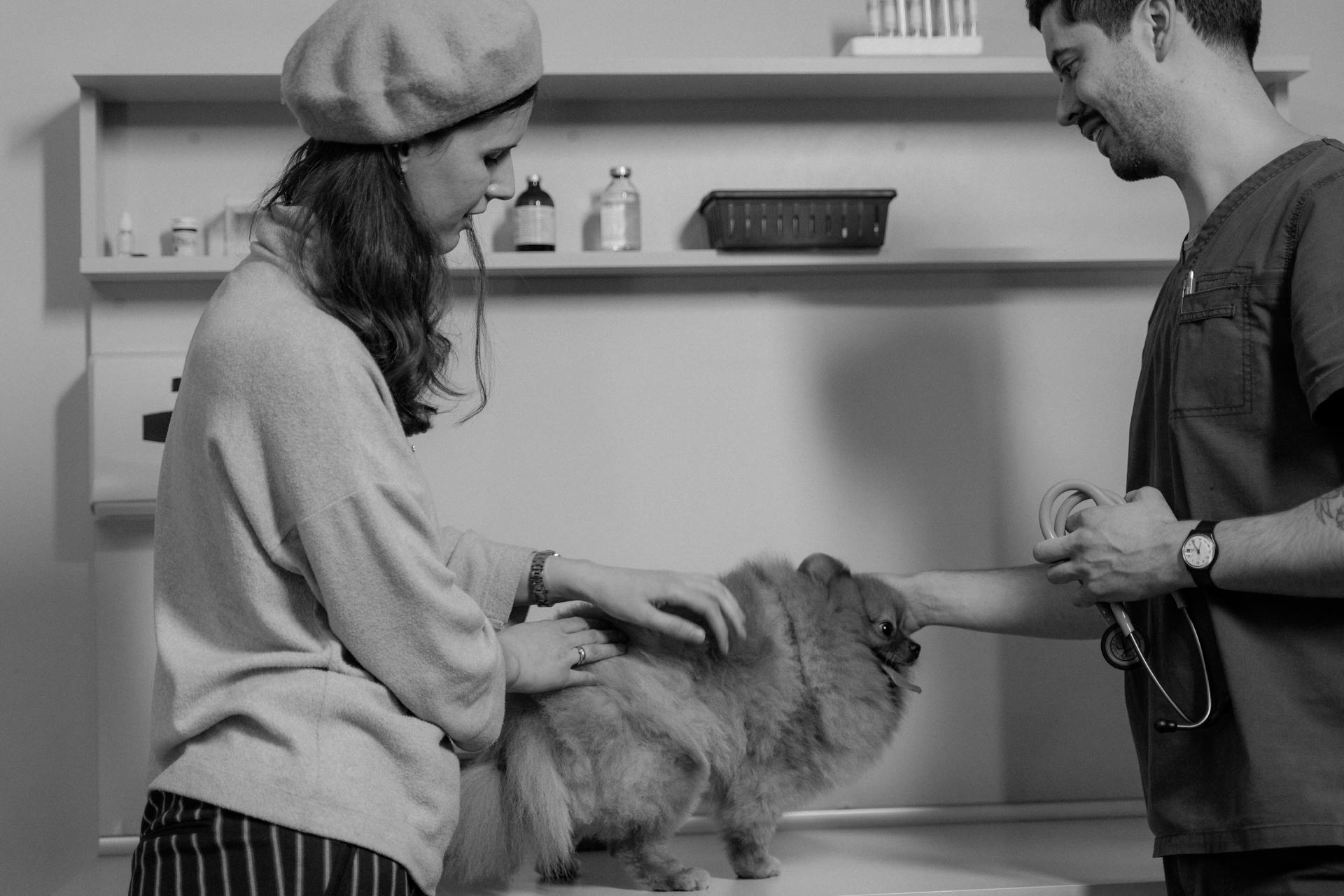
Pyometra in dogs is a serious condition that requires prompt attention. In some cases, antibiotics may be prescribed to treat the infection, but their effectiveness is limited.
The primary cause of pyometra is a bacterial infection that fills the uterus with pus, and antibiotics can help manage the infection. However, the underlying issue is the accumulation of pus, which antibiotics alone cannot resolve.
Antibiotics may be used in conjunction with other treatments, such as surgical intervention, to address the root cause of the problem. In some cases, antibiotics may be the primary treatment, but this is not always the case.
Readers also liked: Can Antibiotics Cause Incontinence in Dogs?
What Is Pyometra in Dogs?
Pyometra in dogs is a highly severe and potentially life-threatening infection of the uterus. It's a serious condition that requires immediate attention.
The infection causes the formation of an abscess or the accumulation of pus within the uterus, which makes the dog very ill. This can happen as early as two to eight weeks after a female dog's heat cycle.
Intriguing read: Female Dog Yeast Infection Treatment
Pyometra is a common condition in dogs who are not spayed and occurs in up to 25% of them. If you suspect your female dog is affected, she needs to be seen by her veterinarian or an emergency veterinarian as soon as possible.
The good news is that this condition is very preventable by having your dog spayed when she is a puppy.
See what others are reading: Can Dog Be Spayed While in Heat?
What Causes It?
Pyometra is caused by a combination of factors that create a perfect environment for a severe bacterial infection. The lining of a female dog's uterus thickens for several weeks in preparation for pregnancy.
This thickening of the uterine lining happens repeatedly during each fertile cycle, known as "heat", if pregnancy doesn't occur. As a result, the lining becomes so thick that cysts will eventually form.
A relaxed cervix, necessary for fertilization, also makes it easier for bacteria to enter the uterus. Weakened muscles of the uterine wall also play a role, as they can't expel infected fluid as they normally would.
The absence of white blood cells in the uterus makes it difficult for the body to fight off the infection. The combination of these factors creates a severe bacterial infection known as pyometra.
Diagnosing Pyometra in Dogs
Diagnosing pyometra in dogs involves a combination of clinical signs, physical examinations, and diagnostic tests.
Your veterinarian will ask about your dog's last season and recent behavior to determine if she's showing signs of pyometra.
They'll also perform physical examinations and check for abdominal swelling.
A sample of vaginal discharge can be collected and analyzed under a microscope to detect bacteria and other cells present after estrus.
Your vet may recommend imaging tests, such as ultrasound or X-rays, to look for a distended, fluid-filled uterus.
Bloodwork is performed to check for evidence of infection and potential kidney involvement.
Dogs with pyometra often have elevated globulins and white blood cell counts, as well as low urine concentration.
However, these changes can be present in any animal with a bacterial infection and aren't enough to make a definitive diagnosis on their own.
If the dog's cervix is closed, your vet may use ultrasound or X-rays to identify signs of pyometra, such as uterine enlargement.
Consider reading: Pyometra Ultrasound Dog
Initial Treatment
Dogs with pyometra need to be stabilized before treatment can begin. This involves restoring normal blood flow to their tissues, correcting electrolyte and glucose imbalances, and treating any underlying infections.
Intravenous (IV) fluid therapy and parenteral antibiotics can help stabilize clinically ill patients. If a dog is not responding to IV support and medical treatment, surgical excision of the infected uterus may be necessary.
The mortality rate associated with pyometra is about 5%, with most deaths caused by secondary endotoxemia and shock. This highlights the importance of prompt and effective treatment.
Bacterial culture and antibiotic susceptibility testing are crucial for confirming the effectiveness of antibiotic therapy. This is especially important in patients with pyometra, where the infection can be severe.
Samples for bacterial culture are typically taken from the surgically excised uterus, but can also be retrieved from the cranial vagina using double-guarded swabs. However, it's essential to note that bacteria grown from cranial vaginal cultures may not be the same as those present in the uterus.
Empiric bactericidal antibiotic therapy should be started immediately, with amoxicillin-clavulanate or a combination of a penicillin and a fluoroquinolone being a good choice based on historical bacterial causes of uterine infection.
Alternative Treatments for Canine Pyometra
Alternative treatments for canine pyometra exist, but they come with considerable risks and potential long-term complications. Prostalgin injections are one such option, but they're only recommended for valuable breeding animals caught in the early stages of open-type pyometra.
This treatment takes about one week and requires hospitalization and monitoring. If your dog is severely ill, she needs immediate life-saving therapy, as improvement of clinical signs should follow after about 48 hours.
Prostalgin injections can cause side effects like vomiting, restlessness, defecation, panting, abdominal pain, and salivation, which usually occur within minutes after administration and can last for several hours.
In cases where Prostalgin injections are not suitable, or if the condition is not caught early, surgical excision of the infected uterus may be required to remove the source of infection and achieve a successful recovery. This is especially true for patients not responding to IV support and medical treatment.
Curious to learn more? Check out: Home Remedies for Pyometra in Dogs
Frequently Asked Questions
What is the best antibiotic for pyometra?
According to the Antibiotic Use Guidelines, the primary recommended antibiotic for pyometra is fluoroquinolone, specifically enrofloxacin, while amoxicillin/clavulanate is a secondary option. This treatment is recommended for companion animals.
Can pyometra resolve on its own?
Pyometra is unlikely to resolve on its own and can be fatal if left untreated, requiring prompt medical attention to prevent serious complications
What is the success rate of pyometra treatment?
Pyometra treatment success rates vary depending on the cervix status: 75-90% for open-cervix cases and 25-40% for closed-cervix cases
Sources
Featured Images: pexels.com


